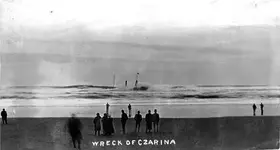Spanish and Asian ships may have contacted the Siuslawans in the 17th and 18th centuries. There is ample evidence of Chinese coins and pottery from the northern part of the Oregon coast. Coos tradition recalls a visit from a Japanese junk, which returned across the Pacific with some local people as passengers. One important geological event took place on Jan. 26, 1700. A monster earthquake calculated at 9.0 on the Richter scale tore apart the Pacific Northwest coastline from Washington state southwards. The effect on the Siuslaw is unknown, but probably many villages were wrecked or inundated by tsunamis.
In the late 18th century, British, Russian and American traders appeared along the coast in increasing numbers, introducing iron and textiles, but also a wave of disastrous epidemics. The first smallpox appeared on the Oregon Coast in 1775, probably introduced by Spanish sailors. Another smallpox epidemic broke out in 1801, and from then on measles, whooping cough, influenza, syphilis and dysentery visited the coast in a deadly series. In 1830 a sickness now believed to be malaria carried off thousands of Western Oregon people, and the Siuslaw population may have been halved again by smallpox in 1836, although at this point a small immunity was beginning to develop. Overall, population plunged from about 3,000 to a few hundred in 30 or 40 years.
In 1828, the Kuitsh attacked and wiped out the Jedediah Smith exploring party at the mouth of the Umpqua, leaving only 3 survivors. Around the same time the Siuslaw destroyed a Chinookan slaving expedition. In the 1830s, huge forest fires devastated the Coast Range landscape, disrupting the local economy and resource base. By the time the settlers arrived in this area in the 1850s, the two peoples had been drastically reduced in number. Open warfare with settlers never afflicted this region of the Coast, but the local tribes were shattered by the combined effects of epidemics, environmental devastation, and cultural extinction.
The Kuitsh were deported north to a desolate reservation at Yachats in the 1850s, where they hung on in desperate conditions until 1875. The surviving Siuslaw mainly stayed in their home area, and gradually their Kuitsh cousins filtered back to the Central Coast. However, language, culture, population, and native lifeways had been terribly damaged. Most of the survivors intermarried or were otherwise submerged in the new settler culture. Tribal identity nevertheless remained strong. Periodically the Siuslaw and Kuitsh, in alliance with their Coos neighbors to the south, sued the federal government for compensation and recognition, but without success. At one point, their case even reached the United Nations, and relations with the federal government remained strained and litigious.
In the 1950s, the tribes were "terminated", along with most of the other tribes of Western Oregon. This meant that they were no longer recognized as Indians by the government. However, this policy is now viewed as a disaster, and a trend towards recognition began in the 1970s. The Confederated Tribes of the Coos, Lower Umpqua, and Siuslaw were recognized by statute in 1984, with an enrolled population of around 500. This means that the Tribes have entered into a new relationship with the United States as a domestic sovereign nation, with tribal headquarters in Coos Bay. Since restoration, the tribal confederation has been rapidly passing new economic, political and cultural milestones, and the future for the descendants of the Siuslaw and Kuitsh looks exceptionally bright.
? Don Macnaughtan
LCC Library
4000 East 30th Ave.
Eugene OR 97405




 I knew you'd come up with something good... I have a hard time with internet searches about my own state for some reason, get overloaded with tons of trash. I'm headed down there next week and wanted to get some good spots for beachcombing. The storms we are getting here are making for some ripe pickings....
I knew you'd come up with something good... I have a hard time with internet searches about my own state for some reason, get overloaded with tons of trash. I'm headed down there next week and wanted to get some good spots for beachcombing. The storms we are getting here are making for some ripe pickings....